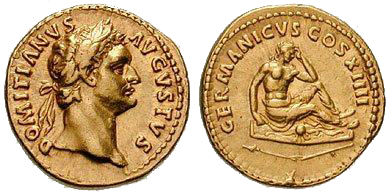Neil S Berman - Expert Numismatist & Gold Coin Dealer
Gold Coins Trade through History
Roman Gold Aureus & Solidus
 Roman Gold Aureus & Solidus 225BC-476AD. The early Roman Republic was a barter based economy in which cattle was the primary means of exchange. Sometime around 269 BC the first cast bronze bars and coins made there appearance. As the need for coinage became apparent, experienced Greek Minters were brought to Rome. Some time after 269 BC the first silver coins were introduced. By 210 BC the principle coins of the empire were bronze and the silver denarius. By 44 BC gold Aureus were commonly struck, and after 54 AD the weight and finesse were gradually reduced until the Fall of Rome in 476AD.
Roman Gold Aureus & Solidus 225BC-476AD. The early Roman Republic was a barter based economy in which cattle was the primary means of exchange. Sometime around 269 BC the first cast bronze bars and coins made there appearance. As the need for coinage became apparent, experienced Greek Minters were brought to Rome. Some time after 269 BC the first silver coins were introduced. By 210 BC the principle coins of the empire were bronze and the silver denarius. By 44 BC gold Aureus were commonly struck, and after 54 AD the weight and finesse were gradually reduced until the Fall of Rome in 476AD.
The original gold Aureus was made forty-four coins to a pound of gold; the original gold Solidus was seventy-two coins to a pound of gold, or about 4.43 grams. The Roman talent was a gold bar weighting 32.71kg also used for trade at that time.
For seven hundred years, at the peak of the empire, at least sixty million, and as many as one hundred thirty million people in a world of three hundred million people used Roman coins. Besides in Italy, Sicily and Crete, Roman coins were used in countries that are now known as Spain, Portugal, France, England, Monaco, Luxembourg, Belgium, Netherlands, Germany, Switzerland, Austria, Czechoslovakia, Hungary, Yugoslavia, Greece, Romania, Bulgaria, Armenia, Turkey, Syria, Iraq, Iran, Lebanon, Jordan, Israel, Turkey, Egypt, Libya, Tunisia, Algeria, Morocco, Saudi Arabia and Cyprus. Millions of Roman gold coins in thousands of types were made in mints all over the empire, and Roman gold coins are still found regularly today in areas formerly part of the Roman Empire fifteen hundred years ago.